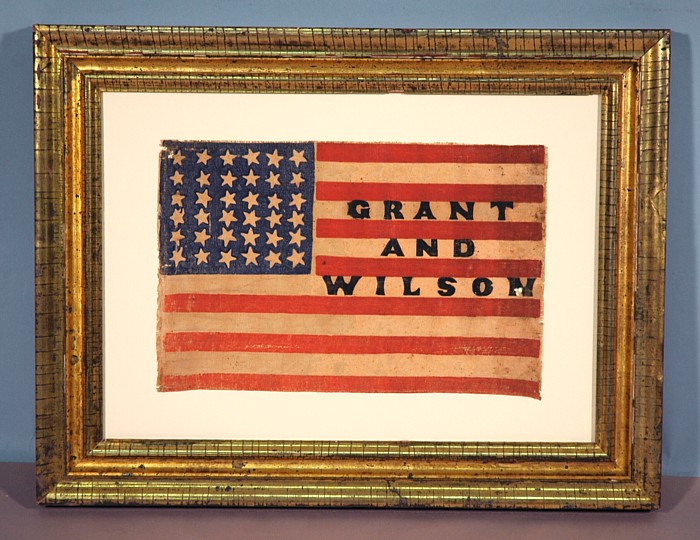
| |
36 STAR OVERPRINTED PARADE FLAG - 1872 PRESIDENTIAL CAMPAIGN OF GRANT & WILSON |
|
| Available: |
Sold |
| Frame Size (H x L): |
18" x 23.5" |
| Flag Size (H x L): |
9.5" x 14.5" |
|
| Description....: |
|
| 36 STAR OVERPRINTED PARADE FLAG FROM THE
1872 PRESIDENTIAL CAMPAIGN OF ULYSSES S. GRANT & HENRY WILSON:
Fantastic 36 star parade flag, printed on coarse, glazed cotton, used in the 1872 presidential campaign of Ulysses S. Grant & Henry Wilson. While eight different varieties of Grant & Colfax (1868) parade flags are pictured in Threads of History: Americana Recorded on Cloth, 1775 to the Present, by Herbert Ridgeway Collins (1979, Smithsonian Press), only two Grant and Wilson varieties are shown and this example is not recorded. Collins formerly served as Curator of Political History at the Smithsonian Institution and his text is widely agreed to be the best available reference for American political textiles. The disparity between the number of flags made for the 1868 campaign vs. the 1872 campaign is actually much greater than this eight to two ratio might suggest. Grant's huge popularity, even after an un-illustrious first term, allowed him to win easily as an incumbent in the second race, defeating Horace Greeley rather easily in the popular vote, 55.6% to 43.8%. Very little flag-making took place for this campaign on either side of the ballot and it is therefore one of the most sought-after elections in political flag collecting.
This was also one of the more interesting races, because Greeley, a Pennsylvania Quaker, actually died on November 29, 1872, after the popular vote had taken place but before the electoral vote could be cast. As a result, electors previously committed to the deceased Greeley voted for four different candidates for president, and eight different candidates for vice president. Three Greeley himself received three posthumous electoral votes, which were afterwards disallowed by Congress.
This particular 36 star flag has stars that are arranged in justified rows, but the printing is very irregular, resulting in stars of many different shapes and sizes, and the stars point in various directions on their vertical axis. Further, while the overprinted lettering was probably done commercially in a cottage industry setting, it is widely spaced and the font is almost childish in nature. These characteristics add great folk qualities to what could have otherwise been a far more benign format.
The 36th state, Nevada, gained statehood during the civil war in 1864. Makers of parade flags would have added a star to their flags at this time, but the 36 star flag did not become official until July 4th, 1865, after the war's end. It was replaced by the 37 star flag in 1867. Note that 36 is one star short of the official star count in 1872. This is sometimes the case with political campaign flags, which often have a number of stars that is one or more behind what was official in the election year. Sometimes campaigning may have started before the election year, though this was not the case here. At other times the star count probably wasn't that important to the person ordering these small, printed flags. The purchaser might have frequently been the campaign manager, but may sometimes have been a private individual who supported the candidate politically and wanted to make a classy display at his/her home or business, or along the campaign route.
Call for a full write-up. |
|
|
|
| Collector Level: |
Flags for the truest Patriots. My best offerings |
|
| Flag Type: |
Parade flag |
|
| Star Count: |
36 |
|
| Earliest Date of Origin: |
1871 |
|
| Latest Date of Origin: |
1872 |
|
| State/Affiliation: |
Nevada |
|
| War Association: |
1866-1889 Indian Wars |
|
| Price: |
SOLD |
|
| |
Views: 2869 |
|
|
|

